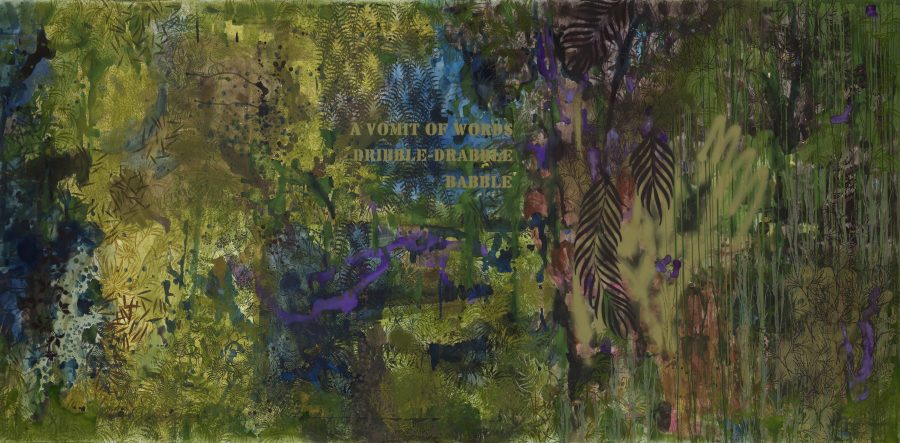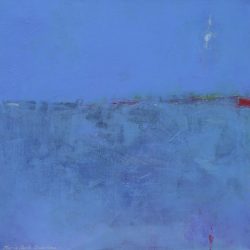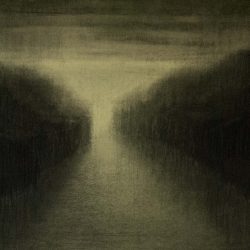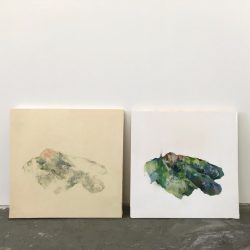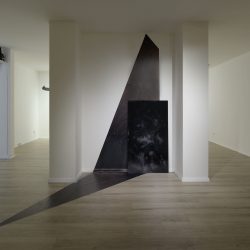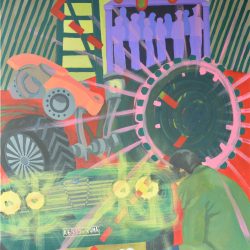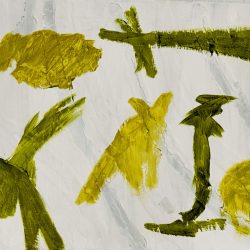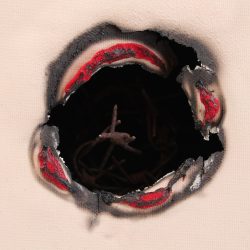work
A Vomit Of Words
| category | Painting |
| subject | Political / Social, Landscape, Nature |
| tags | freestyle landscape, plants, pattern, pattern roller, Gaia, Earth |
| base | 330 cm |
| height | 160 cm |
| depth | 0 cm |
| year | 2020 |
"We are living in a declared state. The "Anthropocene," the name this state has been given, the age of man, posits humanity as a collective oracle: we speak through the Earth, and the Earth speaks through us." (Ashkan Sepavand: MUD: All worlds, all times!)
But when did this age of man, the Anthropocene, begin? With the beginning of the European invasion of America in 1492? With the first human use of fire some 20,000 years ago? With the detonation of the first atomic bomb, on 16 July 1945? When did human behaviour first have global, even geological consequences? The Anthropocene has specific stratigraphic features, technical fossils such as aluminium, concrete remains, plastic particles, carbon compounds from the burning of fossil fuels, fallout from atomic bomb tests are found not only in the sedimentary layers, but also in plants and animals; and in ourselves. Species extinctions have accelerated significantly under human influence. Obviously humans are failing as spokespersons for the earth, the oracle utters "a vomit of words, dribble-drabble, babble, nonsense." (Ashkan Sepavand: MUD: All worlds, all times!)
It is time to shift and abandon the anthropocentric gaze as obsolete. It is high time to put the earth in the centre and to develop a biophilic, geocentric view.
The painting "A Vomit Of Words" is done with gouache, spray paint and acrylics on unstreched canvas. Distorted, fragmentary but nonetheless beautiful landscapes are combined with found quotes and scraps of words that shook me and should do the same to the viewer. It is part of the series "How to Speak about the Earth", which was started in fall 2020. At its heart is the engagement with the the so called "climate crisis" and Bruno Latour's analysis of the current situation in his book "Facing Gaia".
But when did this age of man, the Anthropocene, begin? With the beginning of the European invasion of America in 1492? With the first human use of fire some 20,000 years ago? With the detonation of the first atomic bomb, on 16 July 1945? When did human behaviour first have global, even geological consequences? The Anthropocene has specific stratigraphic features, technical fossils such as aluminium, concrete remains, plastic particles, carbon compounds from the burning of fossil fuels, fallout from atomic bomb tests are found not only in the sedimentary layers, but also in plants and animals; and in ourselves. Species extinctions have accelerated significantly under human influence. Obviously humans are failing as spokespersons for the earth, the oracle utters "a vomit of words, dribble-drabble, babble, nonsense." (Ashkan Sepavand: MUD: All worlds, all times!)
It is time to shift and abandon the anthropocentric gaze as obsolete. It is high time to put the earth in the centre and to develop a biophilic, geocentric view.
The painting "A Vomit Of Words" is done with gouache, spray paint and acrylics on unstreched canvas. Distorted, fragmentary but nonetheless beautiful landscapes are combined with found quotes and scraps of words that shook me and should do the same to the viewer. It is part of the series "How to Speak about the Earth", which was started in fall 2020. At its heart is the engagement with the the so called "climate crisis" and Bruno Latour's analysis of the current situation in his book "Facing Gaia".



